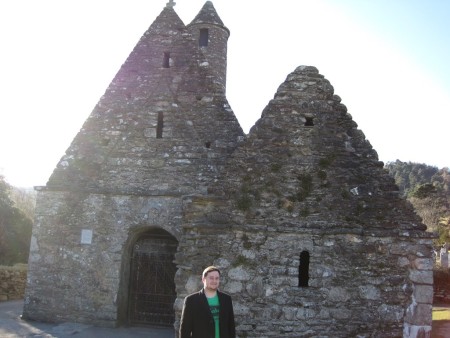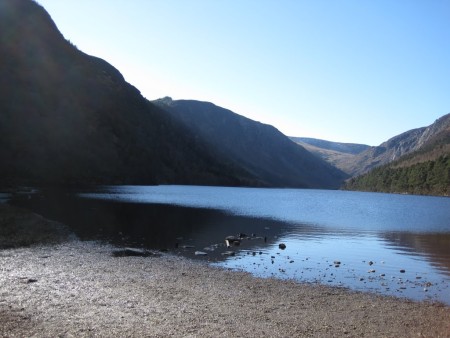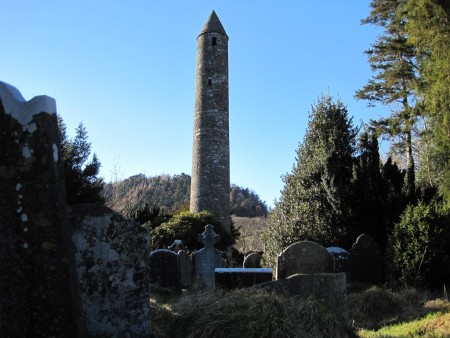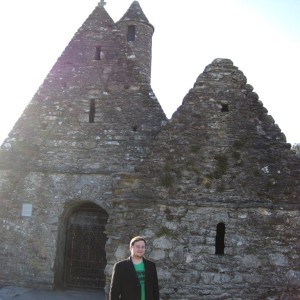So I thought that I’d be able to update the blog this past week, while I was in Ireland, but it turned out, there was lots more driving, and lots less internet than I’d expected. Still, it was a fantastic trip. Anyways, it was a great trip overall, and I saw a ton of great stuff.
On Monday, I went on the Wild Wicklow Tours, which included a stop in Glendalough. In Gaelic, the name is Gleann Dá Loch, meaning “Valley of Two Lakes,” which is exactly what it is. It’s two beautiful lakes nearly completely surrounded by mountains. There’s a little monastic settlement there, which you can see below: What you’re seeing is St. Kevin’s Church, which is a ruin named after the settlement’s founder. St. Kevin was (if memory serves) a 6th century Irish prince who decided to become a hermit monk. He moved further and further into the wilderness, with a group of monks following him (apparently, against his will). They ultimately settled in the valley, while Kevin apparently lived in solitude partway up one of the mountains. So, if my history is correct, it’s Kevin’s followers who really founded the settlement which these pictures are from, while St. Kevin lived partway up one of the hills in the background here:
What you’re seeing is St. Kevin’s Church, which is a ruin named after the settlement’s founder. St. Kevin was (if memory serves) a 6th century Irish prince who decided to become a hermit monk. He moved further and further into the wilderness, with a group of monks following him (apparently, against his will). They ultimately settled in the valley, while Kevin apparently lived in solitude partway up one of the mountains. So, if my history is correct, it’s Kevin’s followers who really founded the settlement which these pictures are from, while St. Kevin lived partway up one of the hills in the background here:
Here’s the inside of another church, known as Glendalough Cathedral (although I’m not sure if it actually served as a cathedral or not):
Monasteries were vital to Irish daily life for civic as well as religious functions (and sometimes a mix of the two, as the presence of the cemetery suggests). This tower served for centuries as a storehouse for the town’s riches:
 When the Vikings attacked, the people would take as much as they could from the tower and run for it, a fact we know because some of their bodies were uncovered in the bog, having been unintentionally buried with their riches. I can’t overstate how beautiful the whole area was: both the natural beauty, and the beautiful simplicity of the settlement.
When the Vikings attacked, the people would take as much as they could from the tower and run for it, a fact we know because some of their bodies were uncovered in the bog, having been unintentionally buried with their riches. I can’t overstate how beautiful the whole area was: both the natural beauty, and the beautiful simplicity of the settlement.
Sadly, the English destroyed much of the settlement in 1398. And perhaps sadder yet, developers in the 1970s destroyed part of the area (dating back to the seventh century) in an ill-conceived attempt to develop a housing area. Still, it stands (even, in parts, as ruins) as a testament to a simpler life, and centuries of continuous monastic devotion to Our Lord.
